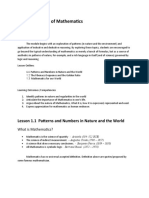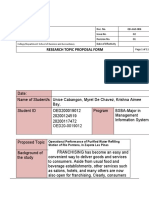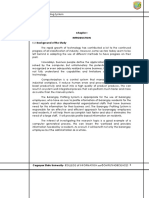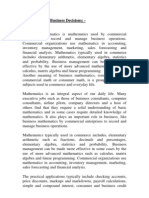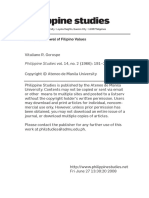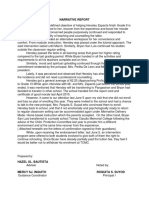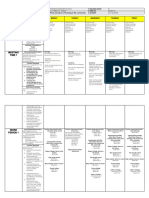Professional Documents
Culture Documents
Extent of Implementation of ELMS and The Participation of STI General Santos City Senior High School Students
Original Title
Copyright
Available Formats
Share this document
Did you find this document useful?
Is this content inappropriate?
Report this DocumentCopyright:
Available Formats
Extent of Implementation of ELMS and The Participation of STI General Santos City Senior High School Students
Copyright:
Available Formats
Volume 5, Issue 10, October – 2020 International Journal of Innovative Science and Research Technology
ISSN No:-2456-2165
Extent of Implementation of ELMS and the
Participation of STI General Santos City Senior
High School Students
Adonis Solidarios Besa
Sultan Kudarat State University – Access Campus, EJC Montilla, Tacurong City
09097373444/09278195156
Abstract:- The title of the study is Implementation of I. INTRODUCTION
ELMS and Participation of STI College General Santos
City Senior High School. It focuses on the Learning is no longer restricted to the pedagogy used
implementation of electronic learning management as a by the teacher. Interactive and adaptive software allows
digital learning tool of STI Senior High School in students to learn in their own style, making learning
General Santos City, Philippines. The problems include personal and engaging. New learning technologies provide
the assessment on the respondents’ literacy level in using real time data that give teachers the information they need to
computers, respondents’ access in internet connections. adjust instruction to meet the unique needs of the students.
The implementation was just started June 2016. The
study uses the descriptive design where an interview The 21st century brings such innovations in the
method is used, a checklist that consists of assessment Philippines Education System that even the parturition of 12
questions and designed with references from manuals, year education become the current concern of educators and
research papers under study. students. In contesting this trend, the Electronic Learning
Management System (ELMS), a digital learning application
The findings of this study are the following: is introduced by STI College nationwide among its Senior
1. The computer literacy level of the respondents is High School Students. This interactive educational system
found to be AVERAGE featuring social networking platform and personal organizer
2. Extent of Accessing Materials and Activities in the that even they were absent, the students have access to their
ELMS is found to be MODERATELY ACCESSIBLE modules, handouts, and assignments, where students can
3. ELMS Assessment is found to be hard or difficult to review, study ahead, and catch up their classroom activities
the students but helpful wherever and whenever with their internet connections.
4. ELMS help them acquire knowledge Sophong, W et al (2013) indicated that this method is a
5. Identified Problems and Recommendation on the formalized learning that occurs in response to distance
implementation of ELMS learning especially those who are not physically present in
school using the internet to promote teaching effectiveness.
Many students encounter problems like poor How does ELMS work? In line with the ever-changing
internet connections due to underdeveloped modern times where students rely on the internet for most of
infrastructure. They have no smart phones or gadgets to their daily activities, it is appropriate for an online system or
be used to comply with the online requirements. Their student portal to be set up to cater to their academic needs as
performance tasks and other related online said by Adzharuddin, N (2013). According to Pastore, M
requirements are most likely affected. Thus, they (2012) common in this ELMS is an automated testing
recommend that the school must have excellent or strong facility which the lecturers assess activities, record answers
internet connections and should have more computer and grades for evaluations.
laboratories where they can freely access with the
ELMS. The availability of excellent connections with This software tools is now used worldwide by a
devices where they can perform their online tasks number of academic institutions switching the traditional
effectively is also a recommendation addressed to the classroom. This digital system is compulsory among the
school administration by the senior high school students, lecturers and learners in delivering contents to the students.
the end users in the implementation of electronic The internet as a computer network linking smaller
learning management system. computer networks is a basic tool in the implementation of
ELMS. The school has to provide internet to access the
Keywords: - lecturers and learners. Rashid, N et al (2002) students should
be allowed to learn anytime, anywhere at their own pace.
Digital Learning System Teachers should keep activities to perform online.
STI Senior High School
General Santos City Philippines
IJISRT20OCT457 www.ijisrt.com 807
Volume 5, Issue 10, October – 2020 International Journal of Innovative Science and Research Technology
ISSN No:-2456-2165
This research is focused on the affectivity of the from different strands or academic programs namely: ABM
implementation of ELMS as a digital learning system – Accountancy and Business Management, HUMSS –
among the senior high school students of STI General Humanities and Social Sciences, GAS – General Academic
Santos City, its influence and the response of the students to Strand and TVL-Technical Vocational Skills regardless of
the latter that seeks answer to the problems. gender and age.
The purpose of this paper is to capture the reactions of A questionnaire in this study is formulated and
the STI Senior High School Students on the implementation undergone series of validation by the experts. It is a
of Electronic Learning Management System (ELMS) checklist which consists of questions that include their
including their problems encountered, suggestions and computer literacy level, access in the internet of their related
recommendations to better the implementation. The findings modules in their respective subjects, online activities and
of this research must be submitted to STI College Head assessments, how the ELMS help in improving their
Office, STI College General Santos City Branch and to competencies and their problems encountered and
some other researchers as their basis to enhance the recommendations for the improvement of its
electronic learning program and other purposes. implementation. The researcher’s observations and
experiences are also considered in constructing the tools.
II. MATERIALS AND METHODS The questions asked to the respondents are carefully
validated by the experts and really suit to the actual
Electronic Learning Management System is a system experiences of the Senior High School students.
owned and implemented by STI College among its Senior
High School students as part of their curricula and academic The researcher conducted the interview in seven
requirements. This is a programmed system through the use working days. The respondents are coming from the
of internet wherein students with their personal accounts can different strands or programs. During the interview, the
explore as long as they are being enrolled by their subject researcher gets the chance to talk with the students,
teacher in the system. With their respective accounts, they converses with them and feeds them some explanations on
can get copies of their handouts, modules and answer the questions not so clear to them. They find time to answer
assessment tools online. Their subject teacher leaves the questionnaire because they believe that the findings of
activities in the system and the students will have to perform this research will help them in the future.
all those during their free time, even at home and any places
they are comfortable. Their activities are graded and After the interview, the researcher encoded all the
computed with percentile in their quarterly grades. Thus, the gathered data, interprets the results through simple tables.
study is likely designed to measure the level of its The data gathered are numerically coded to facilitate
implementation and to get their feedback on the system tabulation to arrive at a frequency distribution and to
delivery. facilitate organizing.
The STI General Santos City Senior High School has III. RESULTS AND DISCUSSION
600 students. As subject of the study, the researcher
interviews 200 respondents comprising 33.33% of the total The following tables show the findings of the study
population. The researcher uses the descriptive design to with the number of respondents and their responses on the
determine the responses of the respondents on the different questions asked in the interview.
problems presented and. The 200 respondents are coming
A. On the Computer Literacy Level
Indicator Elementary Percentage Average Percentage Superior Percentage Mean Remarks
Computer 71 35.5% 103 51.5% 26 13% 1.78 Average
Skills
Table 1:- Computer Literacy Level
.5 – 1.0 Elementary
1.5 – 2.0 Average
2.5 – 3.0 Superior
The above table shows that the respondents’ computer literacy is found to be AVERAGE. Meaning they are skilled in
Microsoft word, excel, power point and can perform activities in the internet.
IJISRT20OCT457 www.ijisrt.com 808
Volume 5, Issue 10, October – 2020 International Journal of Innovative Science and Research Technology
ISSN No:-2456-2165
B. Extent of Accessing Academic Related Modules/Materials, Specialized Courses Handouts, Assignments and Quizzes in the
ELMS.
Indicator LA Percentage SA Percentage MA Percentage VA Percentage Mean Remarks
Academic 8 4% 56 28% 102 51% 34 17% 2.67 MA
Related
Specialized 14 7% 45 22.5% 97 48.5% 44 22% 2.90 MA
Courses
Assignments 17 8.5% 59 29.5% 70 35% 47 23.5% 2.70 MA
Quizzes 15 8% 46 23% 91 46% 50 25% 2.90 MA
Table 2:- Accessing Academic Related Modules/Materials, Specialized Courses Handouts, Assignments and Quizzes in the
ELMS.
.5 – 1.0 – Less Accessible (LA)
1.5 – 2.0 – Slightly Accessible (SA)
2.5 – 3.0 – Moderately Accessible (MA)
3.5 – 4.0 Very Accessible (VA)
Table 2 shows the level of students’ access in the E. Common problems encountered in performing ELMS
internet. Thus, it is noticed that the students have their and their recommendations.
moderate access in the ELMS. They can perform activities The following are the most common problems
and can access to other related requirements. They have encountered by the students in performing the ELMS and
moderate access only considering some problems in the their recommendation to better the implementation.
internet connections.
Problems Recommendations
C. How the users assess ELMS. No internet connections at Open wifi in school
home
Level Frequency Percentage Poor internet connections at The school must have strong
Helpful 69 35% school internet connections
Expensive internet café School provides more
Not helpful 34 17% computer lab with internet
Hard/difficult 83 42% No smart/android phones School allows the use of
and gadgets, laptops laboratory
Easy 12 6%
Limited time in answering Consider the time of
Enjoyable 8 4% ELMS activities submission of activities
Not enjoyable 23 12% ELMS activities are going Schedule the online (ELMS)
together in most subjects activities
Table 3 :- ELMS Assessment Level No materials in the ELMS All subjects must have
for some subjects materials online
Table 3 presents the assessment level whether the Teachers limit attempts in No limits until they finish
ELMS is helpful or not, difficult or easy, enjoyable or not. the ELMS activities the activities
Based on the findings, it is observed that basically ELMS It wastes more time Lessen ELMS activities
among STI Senior High School students is found to be hard Stressful More interactive ELMS
or difficult but helpful. activities
Table 5:- Problems and Recommendations
D. Does ELMS help in acquiring knowledge?
E-Learning is still an emerging market in the
Indicator Yes Percentage No Percentage Philippines. Its use is still sporadic and most users represent
Acquiring 156 78% 44 22% only a small segment of the Philippines education and
knowledge business communities. There is a slow adoption of e-
learning mainly due to underdeveloped infrastructure as
Table 4:- Acquiring knowledge researched by Arimbuyutan, R et al (2007).
Table 4 presents if ELMS help students in acquiring However, despite of the embracing complications the
knowledge. The result justifies that ELMS really help them Philippines has, there are still institutions like STI College
in acquiring knowledge. enthusiastically implemented the ELMS for its teachers and
learners.
IJISRT20OCT457 www.ijisrt.com 809
Volume 5, Issue 10, October – 2020 International Journal of Innovative Science and Research Technology
ISSN No:-2456-2165
In STI College General Santos City Senior High The acceptance of the learning management system is
School (Grade 11), the designed ELMS is instigated as a vital in deciding whether the system is usable and utilized
digital learning system. In this interactive education method by students and instructors. According to the original
they are trying to bring the world in the four corners of the Technology Acceptance Model (TAM), perceived
classroom. Although there are some problems and usefulness is hypothesized to affect intention to use, and
technicalities on its realization, still, the learners keen to perceived ease of use is not hypothesized to directly affect
perform their activities with the internet as being required. intention.
According to Azura and Ling (2013) there are views from
researchers on whether the internet is a good medium for The teachers have very important roles in the
students to search for information, as some agree, while implementation of the system. They must be equipped with
some disagree with this idea. enough technical skills on the use of ELMS and internet.
The learners must also be committed to honestly perform
The ELMS implementation in the locale meets number activities in the ELMS as part of their curricula. Many
of challenges from the learners. These basic problems are instructors restrict themselves to uploading course materials
very technical and can be bases of the implementers to to the course web site and never use the interactive features.
regulate more modifications in the process of its Although many interactive features are available in the
implementation. Students use the internet when they need to LMS, its capacity to use is still limited because of its
gather further information when it comes to understanding demand on the commitments from both instructors and
lectures and ideas for assignments as mentioned by students during a specific time frame.
Adzharuddin, N (2013).
With both teachers and students commitment, with
However, another study of Scurry, DW et al (2005) friendly features of ELMS, very good access in the internet,
found out that there are numerous barriers to the integration the acceptance of this system is likely conceivable.
of instructional technology into higher education, such as
technology infrastructure, faculty effort, technology IV. CONCLUSIONS
satisfaction, and graduates competency.
The online portal has to be a place where students can
According to Schofield and Davision (2002), millions confidently search and obtain information regarding their
of students in the United States and around the world can courses, and also to ensure the accuracy and reliability of the
connect to the internet from their schools. Billions of dollars information as viewed by Adzharuddin, N (2013).
have been spent to provide such access with the expectation
that the information and communication resources the As recommended, to lessen the burden of the teachers
internet provides will improve educational outcomes. Yet and the learners the school will have to provide more
educational benefits do not flow automatically from internet accessible internet connections and computer laboratories as
access. avenue for their online performances. On the part of the
implementers, they suggested to limit the online activities as
As we found out on the results, the learners as the they are also bombarded by some other requirements in the
subjects of this study they are computer literate and can find ILS.
more access in doing their tasks online. However, some of
the major problems they are encountered are the internet Thus, since the ELMS is helpful, they can perform
connections (some have no connections and some have poor their tasks better if they have excellent internet connections
connections), several learners have no devices and many of and more computer laboratories to access their needs.
them have no financial supports to spend in the internet café.
REFERENCES
The learners admitted that the implementation of the
ELMS in school is helpful to them but they feel the [1]. Sarachandran Nair. C. and Dr. RajendraPatil. A study
difficulties especially when slow internet connections are on the impact of learning management systems on
met and when the teachers have almost the same deadlines students of a university college in sultanate of Oman.
of the tasks they require to their students in the ELMS. IJCSI International Journal of Computer Science
Issues, vol.9, Issue 2, No 2, March 2012
Moreover, the respondents also consider ELMS as [2]. M. Pastore.(2001). Internet use continues to pervade
agents to improve their competence like developing their US life.[Online].available:
skills, acquiring knowledge and promoting positive values if http://cyberatlas.Internet.com
the users are not in the level of abusing their access in the [3]. Hancharnchai, A. (2012). “Learning Organization”.
online possibilities. Attitudes and expectations, technical <http://km.rubber.co.th/index.php.?option=com_co
knowledge, classroom culture and Internet culture, ntent&view=article&id-4213:-e-learning-
curriculum design, implementation, and follow-through all &catid=80:learning-organization-lo&Itemid=195>
affect what teachers and students can accomplish with the
internet [9].
IJISRT20OCT457 www.ijisrt.com 810
Volume 5, Issue 10, October – 2020 International Journal of Innovative Science and Research Technology
ISSN No:-2456-2165
[4]. SomphongWathanti and AnuchavadeeChaithongsri.
The use of electronic learning management system to
enhance learning and achievement case study: course
analysis and design students of the program
department of computer information systems.
International Journal of e-Education, e-Business, e-
Management and e-learning, vol.3, No.3, June 2013
[5]. NurAiniBinti Abdul Rashid, Omar Bin Majid, Chow
Shiao Yen. E-learning management system for
secondary school in Malaysia. UniversitiSains
Malaysia, Minden 11800 Penang Malaysia (2002)
[6]. Sam Rauschenberg. Deputy Director, Research,
Policy, and Accountability at Governor’s Office of
Student Achievement, Atlanta, Georgia, LinkedIn
[7]. Reynato C. Arimbuyutan, Seoksoo Kim, Jae-gu Song,
and Wooyoung So. A study on e-learning for
Philippines. International Journal of Multimedia and
Ubiquitous Engineering, vol.2, No.4, October 2007
[8]. Nor AzuraAdzharuddin and Lee Hwei Ling, IACCSIT.
International Journal of e-Education, e-Business, e-
Management and e-learning, vol.3, no.3, June 2013
[9]. J.W. Schonfield and A.L. Davison. Bringing the
internet to school: lessons from the urban district, San
Francisco: Jossey-Bass, 2002
[10]. D.W. Surry, D. C. Ensminger, and M. and Haab. A
model for intergrating instructional technology into
higher education. British Journal of Educational
Technology, vol.36, no.2, pp.327-329, 2005
IJISRT20OCT457 www.ijisrt.com 811
You might also like
- SYS100 SMP3-Module1Document9 pagesSYS100 SMP3-Module1ALDRINNo ratings yet
- MGMT 540 Midterm Exam ReviewDocument9 pagesMGMT 540 Midterm Exam Reviewliu anNo ratings yet
- A Comparative Study of Manual Voting System and E-Voting System For Supreme Student Government Council Election of Paso de Blas National High SchoolDocument27 pagesA Comparative Study of Manual Voting System and E-Voting System For Supreme Student Government Council Election of Paso de Blas National High SchoolLaura JadeNo ratings yet
- Resume ShelwinDocument2 pagesResume ShelwinShelby AntonioNo ratings yet
- AdetDocument6 pagesAdetAnjemar AcostaNo ratings yet
- Week 18 - Whats WrongDocument1 pageWeek 18 - Whats WrongStephanie MaribaoNo ratings yet
- Research Questionnaire SampleDocument2 pagesResearch Questionnaire SampleMark Vic CasanovaNo ratings yet
- An Assesment On The Impact of Converting Used Paper Into Flower Vase For Grade 12 Abm Students at Bestlink College of The Philippines S.Y. 2019-2020Document59 pagesAn Assesment On The Impact of Converting Used Paper Into Flower Vase For Grade 12 Abm Students at Bestlink College of The Philippines S.Y. 2019-2020Jay Ar DadiroNo ratings yet
- Assessment Form 2 PDFDocument29 pagesAssessment Form 2 PDFIam SheynNo ratings yet
- Gregoria de Jesus and The Katipunan: A Case Study AnalysisDocument16 pagesGregoria de Jesus and The Katipunan: A Case Study AnalysisJamie Jimenez CerreroNo ratings yet
- Mr. Dunkin Bakery SCF for 2022Document2 pagesMr. Dunkin Bakery SCF for 2022CHERIE MAY ANGEL QUITORIANONo ratings yet
- Final QuestionnaireDocument5 pagesFinal QuestionnaireSyed Ahsan Hussain XaidiNo ratings yet
- MMW Q1 Mod1Document14 pagesMMW Q1 Mod1Joselito UbaldoNo ratings yet
- Resume Jun 12 2011Document3 pagesResume Jun 12 2011Jr RoqueNo ratings yet
- Outreach ProposalDocument6 pagesOutreach ProposalFernando LomoNo ratings yet
- Title Topic For Business Research For EditingDocument11 pagesTitle Topic For Business Research For EditingKrishna Aimee BayNo ratings yet
- UNIT 3 Problem Solving and ReasoningDocument13 pagesUNIT 3 Problem Solving and ReasoningJr BaranganNo ratings yet
- Proposal 2 SPCPC WEB BASED STUDENT MANAGEMENT SYSTEMDocument46 pagesProposal 2 SPCPC WEB BASED STUDENT MANAGEMENT SYSTEMPauline GozoNo ratings yet
- Name: Christopher N. Postigo Year/Section: Betech-Cet 3A Subject: Life and Works of Rizal DATE: 05/09/2021Document4 pagesName: Christopher N. Postigo Year/Section: Betech-Cet 3A Subject: Life and Works of Rizal DATE: 05/09/2021Christopher PostigoNo ratings yet
- MATH 1100 (Mathematics in The Modern World) First Semester AY 2020-2021Document3 pagesMATH 1100 (Mathematics in The Modern World) First Semester AY 2020-2021JhielaMaeMacaraigNo ratings yet
- Cultural Clothing Hybridization Among BSU StudentsDocument71 pagesCultural Clothing Hybridization Among BSU StudentsJoseph MagsinoNo ratings yet
- Bicycle Wheel Producing Light Through Solar Motor or GravityDocument61 pagesBicycle Wheel Producing Light Through Solar Motor or GravityPrince TalaNo ratings yet
- History of Swot AnalysisDocument42 pagesHistory of Swot Analysiscreation toolsNo ratings yet
- Org7mngt7thweek CherryDocument11 pagesOrg7mngt7thweek CherryChelberrymond Dela CruzNo ratings yet
- Group 11 de La RosaDocument25 pagesGroup 11 de La RosaAngelo DumadoNo ratings yet
- Youth UnemploymentDocument6 pagesYouth UnemploymentJames Clarenze VarronNo ratings yet
- Learning Assessment 1Document2 pagesLearning Assessment 1Edmon AlcazarNo ratings yet
- STS Table FillingDocument2 pagesSTS Table FillingDaniel Gabriel PunoNo ratings yet
- Capstone ProjectDocument58 pagesCapstone ProjectRey Sedigo100% (1)
- Ictict610 Week 2 - Term1 - 2019-1Document4 pagesIctict610 Week 2 - Term1 - 2019-1samwelNo ratings yet
- Barangay Profilling Information SystemDocument113 pagesBarangay Profilling Information SystemAnthony Jade BrosasNo ratings yet
- Dokumen - Tips - Electronic Form 138 and Form 137 Implementation For Basic Sherj Form 138 andDocument13 pagesDokumen - Tips - Electronic Form 138 and Form 137 Implementation For Basic Sherj Form 138 andJustin Dave TiozonNo ratings yet
- Yriarte Jr. Ernesto S. (Activity-03 - Strategies-In-Action)Document6 pagesYriarte Jr. Ernesto S. (Activity-03 - Strategies-In-Action)Ernest S. Yriarte Jr.No ratings yet
- Causes and Effects of Public Speaking Anxiety among E-MQI FreshmenDocument47 pagesCauses and Effects of Public Speaking Anxiety among E-MQI FreshmenVi Diễm QuỳnhNo ratings yet
- Group 3 Task Performance in TQMDocument6 pagesGroup 3 Task Performance in TQMchristine joice bataanNo ratings yet
- ThesisDocument27 pagesThesisjrtlim50% (2)
- Chapter 1 5Document98 pagesChapter 1 5Bryan BallesterosNo ratings yet
- Application Letter + CVDocument4 pagesApplication Letter + CVAgung Agil Saputra100% (1)
- Management Information System Chapter 7 GTU MBADocument46 pagesManagement Information System Chapter 7 GTU MBARushabh VoraNo ratings yet
- (ICB) Latest Business Plan FormatDocument8 pages(ICB) Latest Business Plan FormatEthan Macaivnta100% (1)
- The Social Impact of ICTDocument5 pagesThe Social Impact of ICTflorebelNo ratings yet
- Mathematics in Business DecisionsDocument4 pagesMathematics in Business DecisionsTerence Barretto100% (1)
- Matula CDocument12 pagesMatula CBendo AyaoNo ratings yet
- 5x2 - 2 Term 10x2 - 3 Term 20x2 - 4 Term 40x2 - 5 Term 80x2 - Last TermDocument2 pages5x2 - 2 Term 10x2 - 3 Term 20x2 - 4 Term 40x2 - 5 Term 80x2 - Last TermJhiemalyn RonquilloNo ratings yet
- A Reflection On Why Your Organisation Should Embrace Strategic PlanningDocument2 pagesA Reflection On Why Your Organisation Should Embrace Strategic PlanningJovito LimotNo ratings yet
- Local, Foreign, Unpublished (11 Mawd B)Document8 pagesLocal, Foreign, Unpublished (11 Mawd B)Chollo CaputolNo ratings yet
- Socio-Economic Status as Predictor in Achieving Academic Performance OnlineDocument13 pagesSocio-Economic Status as Predictor in Achieving Academic Performance OnlineMatarong, Francis Michaela M.No ratings yet
- Challenges of pension reforms in Western Balkan countriesDocument10 pagesChallenges of pension reforms in Western Balkan countriesPawan Kumar DubeyNo ratings yet
- Argument Final EssayDocument4 pagesArgument Final Essayapi-509682087No ratings yet
- Chapter 3Document49 pagesChapter 3Adnan QaseemNo ratings yet
- Example of Research PaperDocument6 pagesExample of Research PaperRynne Visto100% (2)
- Logical Malleability, Invisibility Factor, Moral ResponsibilitiesDocument3 pagesLogical Malleability, Invisibility Factor, Moral ResponsibilitiesJordan BasiloniaNo ratings yet
- 1 Practical ResearchhhhhhhhhhDocument9 pages1 Practical ResearchhhhhhhhhhKarley GarciaNo ratings yet
- Capstone Project Proposal Template: Title: Third Eye For The Blind Group: Hades GroupDocument5 pagesCapstone Project Proposal Template: Title: Third Eye For The Blind Group: Hades GroupGeorge Vincent SismarNo ratings yet
- Preparedness of Grade 10 Students in Choosing A Strand/Track in Senior High School at Pamukid National High SchoolDocument3 pagesPreparedness of Grade 10 Students in Choosing A Strand/Track in Senior High School at Pamukid National High SchoolMark CafeNo ratings yet
- Algebra Translating-Phrases Linear-Medium1 PDFDocument2 pagesAlgebra Translating-Phrases Linear-Medium1 PDFMhmd Alrashed100% (1)
- Chapter 1-5Document46 pagesChapter 1-5Mohammed Abu ShaibuNo ratings yet
- MMW Final Exam PDFDocument8 pagesMMW Final Exam PDFRenzo Arvin MatiasNo ratings yet
- Christian Renewal of Filipino Values V GorospeDocument38 pagesChristian Renewal of Filipino Values V GorospeDebbie Angel LorenzanaNo ratings yet
- An Analysis on Mental Health Issues among IndividualsDocument6 pagesAn Analysis on Mental Health Issues among IndividualsInternational Journal of Innovative Science and Research TechnologyNo ratings yet
- Harnessing Open Innovation for Translating Global Languages into Indian LanuagesDocument7 pagesHarnessing Open Innovation for Translating Global Languages into Indian LanuagesInternational Journal of Innovative Science and Research TechnologyNo ratings yet
- Diabetic Retinopathy Stage Detection Using CNN and Inception V3Document9 pagesDiabetic Retinopathy Stage Detection Using CNN and Inception V3International Journal of Innovative Science and Research TechnologyNo ratings yet
- Investigating Factors Influencing Employee Absenteeism: A Case Study of Secondary Schools in MuscatDocument16 pagesInvestigating Factors Influencing Employee Absenteeism: A Case Study of Secondary Schools in MuscatInternational Journal of Innovative Science and Research TechnologyNo ratings yet
- Exploring the Molecular Docking Interactions between the Polyherbal Formulation Ibadhychooranam and Human Aldose Reductase Enzyme as a Novel Approach for Investigating its Potential Efficacy in Management of CataractDocument7 pagesExploring the Molecular Docking Interactions between the Polyherbal Formulation Ibadhychooranam and Human Aldose Reductase Enzyme as a Novel Approach for Investigating its Potential Efficacy in Management of CataractInternational Journal of Innovative Science and Research TechnologyNo ratings yet
- The Making of Object Recognition Eyeglasses for the Visually Impaired using Image AIDocument6 pagesThe Making of Object Recognition Eyeglasses for the Visually Impaired using Image AIInternational Journal of Innovative Science and Research TechnologyNo ratings yet
- The Relationship between Teacher Reflective Practice and Students Engagement in the Public Elementary SchoolDocument31 pagesThe Relationship between Teacher Reflective Practice and Students Engagement in the Public Elementary SchoolInternational Journal of Innovative Science and Research TechnologyNo ratings yet
- Dense Wavelength Division Multiplexing (DWDM) in IT Networks: A Leap Beyond Synchronous Digital Hierarchy (SDH)Document2 pagesDense Wavelength Division Multiplexing (DWDM) in IT Networks: A Leap Beyond Synchronous Digital Hierarchy (SDH)International Journal of Innovative Science and Research TechnologyNo ratings yet
- Comparatively Design and Analyze Elevated Rectangular Water Reservoir with and without Bracing for Different Stagging HeightDocument4 pagesComparatively Design and Analyze Elevated Rectangular Water Reservoir with and without Bracing for Different Stagging HeightInternational Journal of Innovative Science and Research TechnologyNo ratings yet
- The Impact of Digital Marketing Dimensions on Customer SatisfactionDocument6 pagesThe Impact of Digital Marketing Dimensions on Customer SatisfactionInternational Journal of Innovative Science and Research TechnologyNo ratings yet
- Electro-Optics Properties of Intact Cocoa Beans based on Near Infrared TechnologyDocument7 pagesElectro-Optics Properties of Intact Cocoa Beans based on Near Infrared TechnologyInternational Journal of Innovative Science and Research TechnologyNo ratings yet
- Formulation and Evaluation of Poly Herbal Body ScrubDocument6 pagesFormulation and Evaluation of Poly Herbal Body ScrubInternational Journal of Innovative Science and Research TechnologyNo ratings yet
- Advancing Healthcare Predictions: Harnessing Machine Learning for Accurate Health Index PrognosisDocument8 pagesAdvancing Healthcare Predictions: Harnessing Machine Learning for Accurate Health Index PrognosisInternational Journal of Innovative Science and Research TechnologyNo ratings yet
- The Utilization of Date Palm (Phoenix dactylifera) Leaf Fiber as a Main Component in Making an Improvised Water FilterDocument11 pagesThe Utilization of Date Palm (Phoenix dactylifera) Leaf Fiber as a Main Component in Making an Improvised Water FilterInternational Journal of Innovative Science and Research TechnologyNo ratings yet
- Cyberbullying: Legal and Ethical Implications, Challenges and Opportunities for Policy DevelopmentDocument7 pagesCyberbullying: Legal and Ethical Implications, Challenges and Opportunities for Policy DevelopmentInternational Journal of Innovative Science and Research TechnologyNo ratings yet
- Auto Encoder Driven Hybrid Pipelines for Image Deblurring using NAFNETDocument6 pagesAuto Encoder Driven Hybrid Pipelines for Image Deblurring using NAFNETInternational Journal of Innovative Science and Research TechnologyNo ratings yet
- Terracing as an Old-Style Scheme of Soil Water Preservation in Djingliya-Mandara Mountains- CameroonDocument14 pagesTerracing as an Old-Style Scheme of Soil Water Preservation in Djingliya-Mandara Mountains- CameroonInternational Journal of Innovative Science and Research TechnologyNo ratings yet
- A Survey of the Plastic Waste used in Paving BlocksDocument4 pagesA Survey of the Plastic Waste used in Paving BlocksInternational Journal of Innovative Science and Research TechnologyNo ratings yet
- Hepatic Portovenous Gas in a Young MaleDocument2 pagesHepatic Portovenous Gas in a Young MaleInternational Journal of Innovative Science and Research TechnologyNo ratings yet
- Design, Development and Evaluation of Methi-Shikakai Herbal ShampooDocument8 pagesDesign, Development and Evaluation of Methi-Shikakai Herbal ShampooInternational Journal of Innovative Science and Research Technology100% (3)
- Explorning the Role of Machine Learning in Enhancing Cloud SecurityDocument5 pagesExplorning the Role of Machine Learning in Enhancing Cloud SecurityInternational Journal of Innovative Science and Research TechnologyNo ratings yet
- A Review: Pink Eye Outbreak in IndiaDocument3 pagesA Review: Pink Eye Outbreak in IndiaInternational Journal of Innovative Science and Research TechnologyNo ratings yet
- Automatic Power Factor ControllerDocument4 pagesAutomatic Power Factor ControllerInternational Journal of Innovative Science and Research TechnologyNo ratings yet
- Review of Biomechanics in Footwear Design and Development: An Exploration of Key Concepts and InnovationsDocument5 pagesReview of Biomechanics in Footwear Design and Development: An Exploration of Key Concepts and InnovationsInternational Journal of Innovative Science and Research TechnologyNo ratings yet
- Mobile Distractions among Adolescents: Impact on Learning in the Aftermath of COVID-19 in IndiaDocument2 pagesMobile Distractions among Adolescents: Impact on Learning in the Aftermath of COVID-19 in IndiaInternational Journal of Innovative Science and Research TechnologyNo ratings yet
- Studying the Situation and Proposing Some Basic Solutions to Improve Psychological Harmony Between Managerial Staff and Students of Medical Universities in Hanoi AreaDocument5 pagesStudying the Situation and Proposing Some Basic Solutions to Improve Psychological Harmony Between Managerial Staff and Students of Medical Universities in Hanoi AreaInternational Journal of Innovative Science and Research TechnologyNo ratings yet
- Navigating Digitalization: AHP Insights for SMEs' Strategic TransformationDocument11 pagesNavigating Digitalization: AHP Insights for SMEs' Strategic TransformationInternational Journal of Innovative Science and Research Technology100% (1)
- Drug Dosage Control System Using Reinforcement LearningDocument8 pagesDrug Dosage Control System Using Reinforcement LearningInternational Journal of Innovative Science and Research TechnologyNo ratings yet
- The Effect of Time Variables as Predictors of Senior Secondary School Students' Mathematical Performance Department of Mathematics Education Freetown PolytechnicDocument7 pagesThe Effect of Time Variables as Predictors of Senior Secondary School Students' Mathematical Performance Department of Mathematics Education Freetown PolytechnicInternational Journal of Innovative Science and Research TechnologyNo ratings yet
- Formation of New Technology in Automated Highway System in Peripheral HighwayDocument6 pagesFormation of New Technology in Automated Highway System in Peripheral HighwayInternational Journal of Innovative Science and Research TechnologyNo ratings yet
- TILLS Sampler 2021 1Document28 pagesTILLS Sampler 2021 1Johanna Steffie Arun KumarNo ratings yet
- The Research Base For Reading MasteryDocument23 pagesThe Research Base For Reading Masterycayla mae carlosNo ratings yet
- Standards-Based AssessmentDocument5 pagesStandards-Based AssessmentN. Fajar PribadiNo ratings yet
- Improve Student Reading with Interactive MultimediaDocument10 pagesImprove Student Reading with Interactive MultimediaPrincess May Geronimo ParaynoNo ratings yet
- University at Buffalo Presidential Scholarship Application-2Document3 pagesUniversity at Buffalo Presidential Scholarship Application-2sadffdsafdsaNo ratings yet
- Curriculum Vitae A.i.depayDocument3 pagesCurriculum Vitae A.i.depayQueen Ann NavalloNo ratings yet
- Narrative Report: Prepared byDocument3 pagesNarrative Report: Prepared byHazelBautistaNo ratings yet
- Activity 2 (Buble Chart)Document1 pageActivity 2 (Buble Chart)Darryl Mae BaricuatroNo ratings yet
- Welcome To INFO363Document1 pageWelcome To INFO363Joe KingNo ratings yet
- Talent management analysisDocument17 pagesTalent management analysisSamiul AzamNo ratings yet
- Learning How To Learn Teacher Guide PDFDocument9 pagesLearning How To Learn Teacher Guide PDFErick Zúniga100% (3)
- Ongoing Teacher Training by Dep-Ed in the 4th Industrial RevolutionDocument12 pagesOngoing Teacher Training by Dep-Ed in the 4th Industrial RevolutionRichen Makig-angay100% (2)
- AR-Proposal of Jonna M. AbellanaDocument16 pagesAR-Proposal of Jonna M. AbellanaJonna AbellanaNo ratings yet
- Instructional Media: Presented By: Claire Anne CleofasDocument7 pagesInstructional Media: Presented By: Claire Anne CleofasKean KimNo ratings yet
- Demonstration Lesson Plan For Grade 9 Maintenance and RepairDocument3 pagesDemonstration Lesson Plan For Grade 9 Maintenance and RepairGerean Abeleda-VillasNo ratings yet
- Fostering Creativity in Young ChildrenDocument51 pagesFostering Creativity in Young ChildrenFretzel Vann AyoonNo ratings yet
- WMSU Administration Officers and CollegesDocument5 pagesWMSU Administration Officers and CollegesLyza LeeNo ratings yet
- Frontloading StrategyDocument2 pagesFrontloading Strategyapi-312958652100% (1)
- Subsumption Theory: David Paul AusubelDocument18 pagesSubsumption Theory: David Paul AusubelTrixie Mae Issobelle RemorozaNo ratings yet
- Unpacking Essential Learning CompetenciesDocument2 pagesUnpacking Essential Learning CompetenciesMaria Camille Caylan100% (1)
- Basic Concepts, Theories, and Principles in Assessing Learning (Alternative Methods)Document13 pagesBasic Concepts, Theories, and Principles in Assessing Learning (Alternative Methods)Cha Cha Hk0% (1)
- Montage RubricsDocument1 pageMontage Rubricsapi-261925424No ratings yet
- July 2018 HboeDocument27 pagesJuly 2018 HboeAnthony PetrosinoNo ratings yet
- Nation With Namo Cover Letter - Abhay GuptaDocument1 pageNation With Namo Cover Letter - Abhay GuptaAbhay GuptaNo ratings yet
- Course Outline: Current Issues On ELTDocument5 pagesCourse Outline: Current Issues On ELTfujionoNo ratings yet
- g12 Maths Sample Lesson PlanDocument3 pagesg12 Maths Sample Lesson Planmakunguwillbroad52No ratings yet
- Southeast Asia 6-1 Lesson PlanDocument3 pagesSoutheast Asia 6-1 Lesson Planapi-249878274100% (1)
- Kinder DLL Week 23Document7 pagesKinder DLL Week 23Mary Grace EvangelistaNo ratings yet
- FS2 Le5Document67 pagesFS2 Le5Patrick BuentiempoNo ratings yet
- Technical Assistance Reporting Log: Republic of The Philippines Department of EducationDocument10 pagesTechnical Assistance Reporting Log: Republic of The Philippines Department of EducationAlma Dimaranan-AcuñaNo ratings yet
- The Power of Our Supreme Court: How Supreme Court Cases Shape DemocracyFrom EverandThe Power of Our Supreme Court: How Supreme Court Cases Shape DemocracyRating: 5 out of 5 stars5/5 (2)
- Social Anxiety and Shyness: The definitive guide to learn How to Become Self-Confident with Self-Esteem and Cognitive Behavioral Therapy. Stop Being Dominated by ShynessFrom EverandSocial Anxiety and Shyness: The definitive guide to learn How to Become Self-Confident with Self-Esteem and Cognitive Behavioral Therapy. Stop Being Dominated by ShynessRating: 5 out of 5 stars5/5 (11)
- Economics for Kids - Understanding the Basics of An Economy | Economics 101 for Children | 3rd Grade Social StudiesFrom EverandEconomics for Kids - Understanding the Basics of An Economy | Economics 101 for Children | 3rd Grade Social StudiesNo ratings yet
- Teacher Guide for Three Feathers: Exploring Healing and Justice Through Graphic Storytelling in Grades 7–12From EverandTeacher Guide for Three Feathers: Exploring Healing and Justice Through Graphic Storytelling in Grades 7–12No ratings yet
- Indigenous Storywork: Educating the Heart, Mind, Body, and SpiritFrom EverandIndigenous Storywork: Educating the Heart, Mind, Body, and SpiritNo ratings yet
- World Geography - Time & Climate Zones - Latitude, Longitude, Tropics, Meridian and More | Geography for Kids | 5th Grade Social StudiesFrom EverandWorld Geography - Time & Climate Zones - Latitude, Longitude, Tropics, Meridian and More | Geography for Kids | 5th Grade Social StudiesRating: 5 out of 5 stars5/5 (2)
- Comprehensive Peace Education: Educating for Global ResponsibilityFrom EverandComprehensive Peace Education: Educating for Global ResponsibilityNo ratings yet
- A Student's Guide to Political PhilosophyFrom EverandA Student's Guide to Political PhilosophyRating: 3.5 out of 5 stars3.5/5 (18)
- Conversation Skills: Learn How to Improve your Conversational Intelligence and Handle Fierce, Tough or Crucial Social Interactions Like a ProFrom EverandConversation Skills: Learn How to Improve your Conversational Intelligence and Handle Fierce, Tough or Crucial Social Interactions Like a ProNo ratings yet
- U.S. History Skillbook: Practice and Application of Historical Thinking Skills for AP U.S. HistoryFrom EverandU.S. History Skillbook: Practice and Application of Historical Thinking Skills for AP U.S. HistoryNo ratings yet
- World Geography Puzzles: Countries of the World, Grades 5 - 12From EverandWorld Geography Puzzles: Countries of the World, Grades 5 - 12No ratings yet













